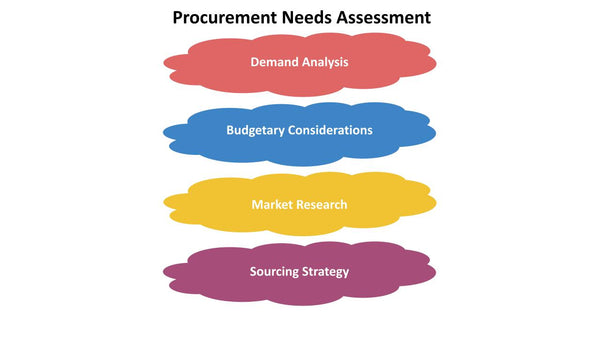Comprehensive Guide to the Purchasing Process: From Procurement to Payment
Effective procurement and purchasing processes are critical for the success of any organization, regardless of its size or industry. A well-structured and efficient purchasing process ensures that an organization can acquire the goods and services it needs while optimizing costs, maintaining quality, and adhering to regulatory requirements. In this comprehensive guide, we will explore the purchasing process in-depth, from the initial procurement needs assessment to the final payment to suppliers. By understanding the key stages and best practices involved in the purchasing process, organizations can streamline their operations and achieve better outcomes.

Chapter 1: Procurement Needs Assessment
The first step in the purchasing process is identifying and assessing the organization's procurement needs. This phase involves:
- Demand Analysis: Analyzing the demand for goods and services by different departments or business units within the organization. This helps in understanding the volume and variety of items required.
- Budgetary Considerations: Evaluating the available budget for procurement and determining if it aligns with the identified needs. Adjustments may be necessary based on budget constraints.
- Market Research: Conduct research to identify potential suppliers, assess market conditions, and gather information about pricing and availability.
- Sourcing Strategy: Develop a sourcing strategy that outlines whether procurement will be centralized or decentralized and the criteria for selecting suppliers.
Chapter 2: Supplier Selection and Evaluation
Once procurement needs are identified, the organization moves on to supplier selection and evaluation. This involves:
- Supplier Identification: Creating a list of potential suppliers based on market research, referrals, or existing relationships.
- Supplier Qualification: Assessing potential suppliers' capabilities, financial stability, past performance, and compliance with regulatory requirements.
- Request for Information (RFI): Issuing RFIs to shortlisted suppliers to gather detailed information about their products, services, and pricing.
- Request for Proposal (RFP): Sending RFPs to a select group of suppliers, specifying detailed requirements and requesting formal proposals.
- Supplier Evaluation: Evaluating supplier proposals based on predefined criteria, which may include cost, quality, reliability, and sustainability.
Chapter 3: Procurement and Purchase Orders
Once suppliers are selected, the actual procurement process begins:
- Purchase Requisition: Receiving purchase requisitions from various departments or business units indicating their procurement needs
- Purchase Order (PO) Creation: Creating purchase orders based on the approved requisitions, specifying details such as quantities, specifications, and delivery timelines
- Supplier Confirmation: Sending the PO to the chosen supplier, who then acknowledges receipt and agrees to fulfill the order as specified.
- Order Tracking: Monitoring the progress of orders to ensure they are on track for timely delivery and addressing any potential issues.
Chapter 4: Receipt and Inspection
After the supplier delivers the goods or services, organizations must receive and inspect them:
- Goods Receipt: Receiving and confirming the delivery of goods or services as per the PO.
- Inspection: Conducting a quality check to ensure that the received items meet the specified standards and are free from defects.
- Acceptance or Rejection: Deciding whether to accept or reject the received goods or services. Rejected items may trigger returns or dispute resolution.
Chapter 5: Invoice Verification and Approval
This stage involves the processing of supplier invoices:
- Invoice Receipt: Receiving supplier invoices, which should match the PO and goods receipt.
- Invoice Verification: Verifying the accuracy of the invoice, including quantity, price, and any applicable discounts or taxes.
- Approval Workflow: Routing the invoice for approval within the organization, typically involving multiple stakeholders and levels of approval.
- Payment Approval: Once approved, authorizing payment to the supplier based on the agreed-upon terms.
Chapter 6: Payment and Record-Keeping
The final step in the purchasing process involves making payments and maintaining records:
- Payment Processing: Executing payments to suppliers, which can be done through various methods, including checks, electronic transfers, or credit cards.
- Record Keeping: Maintaining comprehensive records of all procurement-related transactions, including invoices, purchase orders, receipts, and payment documentation.
- Supplier Relationship Management: Continuously managing relationships with suppliers to ensure ongoing quality, performance, and compliance.
Chapter 7: Continuous Improvement and Analysis
To ensure the efficiency and effectiveness of the purchasing process, organizations should regularly review and improve their procurement practices. This includes:
- Performance Metrics: Defining key performance indicators (KPIs) to measure the effectiveness of the purchasing process, such as cost savings, on-time deliveries, and supplier performance.
- Root Cause Analysis: Identifying the root causes of any issues or bottlenecks in the procurement process and implementing corrective actions.
- Supplier Feedback: Collect feedback from suppliers to gain insights into areas for improvement and collaboration.
- Technology Integration: Leveraging procurement software and tools to streamline processes, enhance visibility, and reduce manual work.
Chapter 8: Compliance and Risk Management
Compliance and risk management are ongoing considerations in the purchasing process:
- Regulatory Compliance: Ensuring that all procurement activities adhere to relevant laws, regulations, and industry standards, particularly in highly regulated industries.
- Risk Mitigation: Identifying and mitigating risks associated with supplier relationships, market volatility, geopolitical factors, and other external influences.
- Contract Management: Effectively managing supplier contracts to ensure compliance with agreed-upon terms and conditions.
Conclusion
A well-structured and efficient purchasing process is vital for organizations to acquire goods and services while optimizing costs, maintaining quality, and adhering to regulatory requirements. By following the comprehensive guide outlined in this blog, organizations can effectively manage the entire procurement lifecycle, from needs assessment to payment, and continuously improve their purchasing practices. In doing so, they can achieve better control over costs, enhance supplier relationships, and contribute to their overall success in today's competitive business environment.

